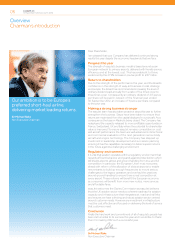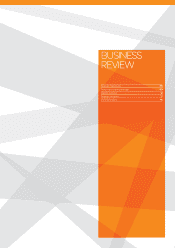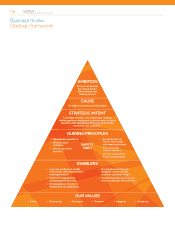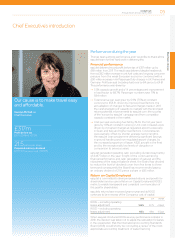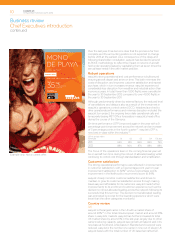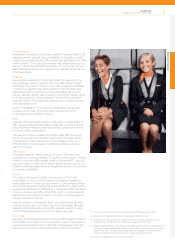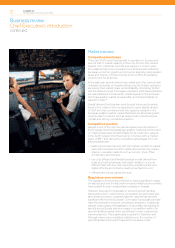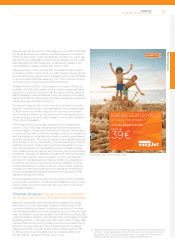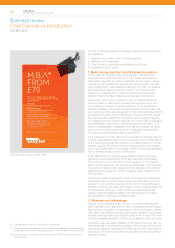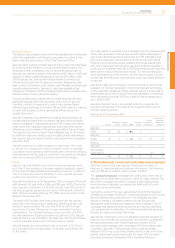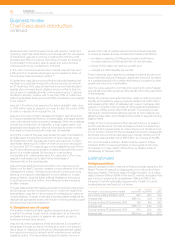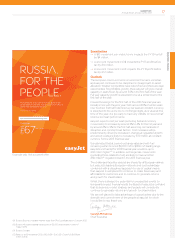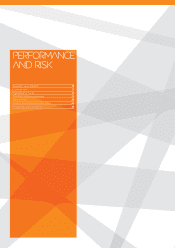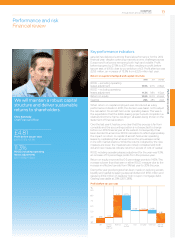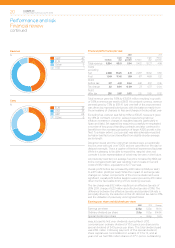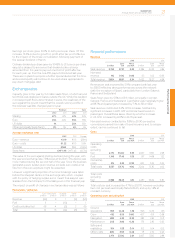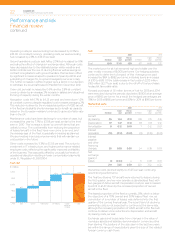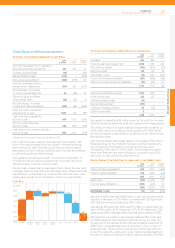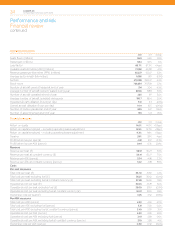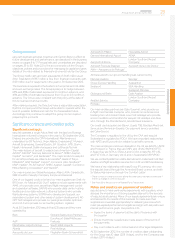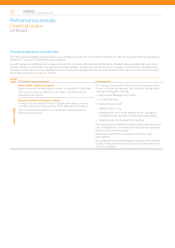EasyJet 2012 Annual Report Download - page 18
Download and view the complete annual report
Please find page 18 of the 2012 EasyJet annual report below. You can navigate through the pages in the report by either clicking on the pages listed below, or by using the keyword search tool below to find specific information within the annual report.
excess of its cost of capital. easyJet has the following targets
toensure its capital structure remains both robust and efficient:
A a maximum gearing of 50% giving investors and finance
providers assurance that easyJet will not over-leverage;
A a limit of £10 million net debt per aircraft; and
A a target £4 million liquidity per aircraft.
These measures allow easyJet to withstand external shocks such
asan extended closure of airspace, significant fuel price increases
ora sustained period of low yields whilst being in a position to drive
growth and returns for shareholders.
Over the cycle, easyJet is committed to covering its cost of capital,
and will self-fund both growth and the dividend from the cash flows
of the business.
During the year good progress has been made on reducing excess
liquidity and capital by paying a special dividend of £150 million
andrepaying £162 million of relatively high coupon mortgage debt.
easyJet is currently in the process of closing sale and leasebacks
for12 new A320s and 12 older A319 aircraft. The tender process
washeavily oversubscribed allowing easyJet to close deals at very
attractive lease rates; demonstrating the benefit of easyJet’s strong
balance sheet.
In light of the continued strong financial performance of easyJet
and the robustness of the easyJet balance sheet, the Board has
decided that it is appropriate to reduce the level of dividend cover
from 5 times to 3 times for the foreseeable future and consequently
the Board has recommended paying an ordinary dividend of 21.5
pence per share at total cost of £85 million, an increase of 104.8%.
The recommended ordinary dividend will be paid on Friday
22March 2013 to those shareholders on the register at the close
ofbusiness on Friday 1 March 2013 with an ex-dividend date of
Wednesday 27 February 2013.
Looking forward
Hedging positions
easyJet operates under a clear set of treasury policies agreed by the
Board. The aim of easyJet’s hedging policy is to reduce short term
earnings volatility. Therefore, easyJet hedges forward, on a rolling
basis, between 65% and 85% of the next 12 months’ anticipated fuel
and currency requirements and between 45% and 65% of the
following 12 months’ anticipated requirements. Details of current
hedging arrangements are set out below:
Percentage of anticipated requirement hedged
Fuel
requirement
US Dollar
requirement
Euro
surplus
Six months ending 31 March 2013 86% 86% 76%
Average rate $986 m/t $1.61 €1.18
Full year ending 30 September 2013 78% 81% 68%
Average rate $985 m/t $1.60 €1.18
Full year ending 30 September 2014 55% 62% 48%
Average rate $993 m/t $1.58 €1.22
Express) and by reaching agreements with specific customers
(including major high street banks) and recently with the UK Houses
of Parliament. easyJet is working in partnership with the GDS
providers and TMCs to improve technology to make the booking
functionality for third party agents easier and expects these
improvements to be completed in mid-2013.
In the cost conscious business travel market, easyJet has seen
a6%growth in business passengers and increased its share of
theEuropean business travel market. (9)
In September, easyJet announced that its allocated seating trial
hadbeen successful and would be rolled out across its network
by27November 2012. easyJet was keen to ensure that allocated
seating did not impact asset utilisation and is confident that the
roll-out will not materially diminish on-time performance. Customer
feedback has been positive with more than 70% of customers
preferring allocated seating and over 60% more likely to use easyJet
in the future(10).
easyJet is the third most searched for airline globally(11) with close
to400 million visits to easyJet.com over the last 12 months. 60%
ofvisitors originate from outside the UK.
easyJet.com’s new content management system was introduced
toimprove operational efficiency, increase agility, and target specific
users with relevant route pricing and messages. Other new initiatives
include the introduction of InspireMe, a map based search tool
targeting those people who may not know exactly where or when
they want to travel, and specific Swiss and US websites.
During the course of the year, easyJet also focused on broadening
its digital reach through the introduction of new channels. As at
30September 2012, the easyJet mobile app had over 3 million
downloads delivering £42 million of revenue since its introduction
inDecember 2011. The easyJet app is now available through iPhone
and Android devices and has been complemented with the recent
launch of a mobile website. By focusing on core booking
functionality and “making travel easy” for customers on the move,
easyJet is well positioned to take further advantage of
developments in this growing area.
easyJet made significant improvements in the way it prices its
flights over the last 12 months, investing in improvements to its yield
management system. Developments include continuous pricing
allowing more specific yield algorithms to be utilised on a wider
range of flights, using the latest artificial intelligence techniques
tooptimise pricing, and further unbundling and yield managing
ancillarycharges.
Through partnerships with leading providers (including booking.com
and Europcar) and an increased focus on customer insight and
segmentation, easyJet is in the process of overhauling its customer
contact strategy. A range of relevant and personalised emails will be
deployed at appropriate points with the aim of driving ancillary upsell
and improving customer experience.
4. Disciplined use of capital
The aviation market is a highly capital intensive industry and it is
important for airlines to pay careful consideration to its financing
and balance sheet position to balance risk, growth, access to
funding and shareholder returns.
easyJet has a strong balance sheet and derives a competitive
advantage through access to funding at a lower cost. easyJet
has a range of measures and tools to effectively allocate capital
and resources across its network whilst maintaining an optimal
capital structure. This has enabled easyJet to deliver returns in
Business review
Chief Executive’s introduction
continued
easyJet plc
Annual report and accounts 2012
16


